Disney Wildlife: Florida’s Native Birds
The Magic Kingdom’s most famous birds might live in the Enchanted Tiki Room, but Disney World’s native birds far out-number the singing and talking ones in Adventureland. All around Walt Disney World Resort, you’ll see magnificent tropical birds, native to Florida and happily adapted to life in a theme park. It’s Disney wildlife: Florida’s native animals living right there amongst the attractions. Thanks to central Florida’s waterlogged environment, many of the most distinctive species are wading birds, inhabiting the trees and rooftops around the Seven Seas Lagoon, Bay Lake, and even Frontierland‘s Rivers of America.
Most people just point and call them storks, or flamingos. But you want to look more clever than that, right? So here’s your guide to the native birds of Walt Disney World. Here are some tips: only one of these birds is a stork, and the only flamingos you’ll find are on Kilimanjaro Safaris.
Great Egret: One of the most elegant birds you’ll ever see, the great egret stands more than three feet tall. Although the egret has the long legs and neck of a wading bird, you’ll often find them perched high in trees or on the roofs of show buildings at Disney. Their diet isn’t limited to seafood either — I’ve seen egrets flying over with long wriggling snakes dangling from their beaks. And they think they ought to live on turkey legs — great egrets stalk guests near the Turkey Leg cart in Frontierland, waiting for hand-outs. While it is funny to watch an unsuspecting tourist turn around and let out a scream at the giant bird lurking behind them, turkey skin isn’t in their natural diet at all. Don’t feed them and encourage the madness.
Keep your eyes open for smaller egrets around Disney World, including the less-common Snowy Egret, which has amazing breeding plumage feathers in spring, as well as bright yellow feet, and the Cattle Egret, a small white egret often seen foraging for insects in roadside verges and grasslands.
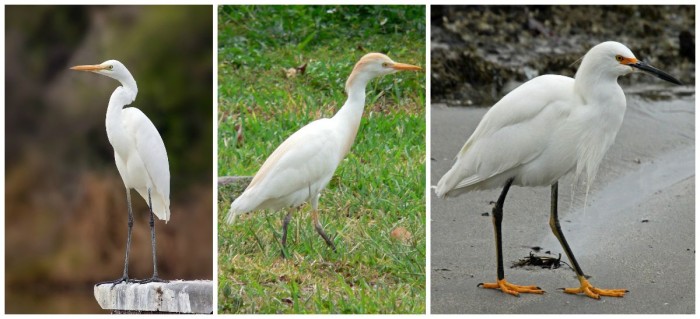
All call Walt Disney World home. Images: Wikipedia
Ibis: The most common variety of ibis at Disney is the American white ibis. With distinctive long red beaks and red legs, these little wading birds love to hang out near the Rivers of America and snap up bits of turkey leg. If tourists aren’t feeding them, though, they’re in waterways scooping up crayfish and small fish. Ibis are like pigeons–they’re everywhere, they’re not very scared of humans, and they’ll eat just about anything. Old-school Floridians called these birds Chokoloskee Chickens, but they’re protected from the stew-pot today by the U.S. Migratory Bird Treaty Act. Watch for ibis flying over in flocks at sunset, or perched in trees in secluded areas as you’re driving around WDW property.
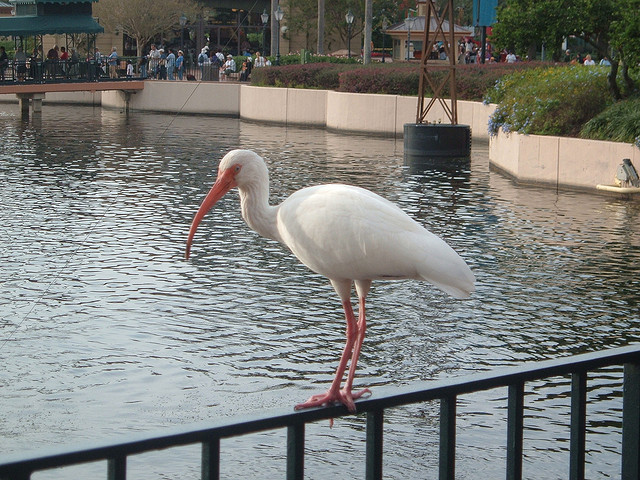
Wood Stork: A massive white bird with black-tipped wings and a distinctive mottled head, the Wood Stork is the only stork with breeding grounds in the United States. Recently upgraded from “endangered” to “threatened,” on the Endangered Species List, wood storks live in colonies in wetland trees, and stalk fish in canals and waterways around Disney. One of the most-studied rookeries in North America is in the Disney Wilderness Preserve, watched over by scientists from Disney’s Animal Kingdom, but you’ll find a few here on property. They’re shier than many wading birds, so watch for them in more natural, quiet areas around the World.
Sandhill Crane: Four feet tall, flying in groups, and with a loud call that is half rattle, half whoop, and completely indescribable, you’ll know a Sandhill Crane when you see one. They winter in Florida, living in family groups and frequently returning to the same nesting grounds year after year. Listen for them to fly over near sunset, or watch for families picking up insects in the grasslands near the Contemporary and the Seven Seas Lagoon.
Great Blue Heron: Like the Great Egret, this is a dramatic and elegant bird. Great Blue Herons are often more than four feet tall, and most of that height is neck and leg. You’ll find them fishing in waterways and the shores of Disney’s lakes, or huddled up in trees, watching the activity below. A white face and streak down the neck, plus their massive size, will help you distinguish Great Blue Herons from the much smaller and less common Louisiana Heron. You might also spot Little Blue Herons, a considerably smaller and less flashy cousin.
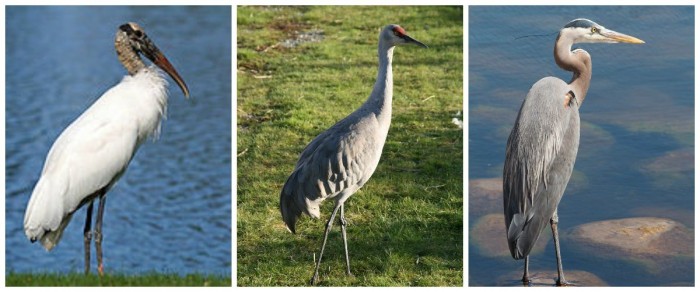
Anhinga: Nicknamed the “Snakebird,” Anhingas swim and hunt underwater, but don’t have the protection of waterproof feathers. Consequently, the anhinga’s feathers grow so waterlogged on fishing expeditions that after a while, only their long neck remains above the water. The anhinga’s sinuous neck looks like alarmingly like a snake in the water, hence the common name. Once they finally clamber out of the water, they have to spread their wings to dry, sometimes flapping them gently to speed things along. Keep an eye out for their necks and heads peeking out of natural bodies of water and in the Rivers of America, and watch for perched anhingas drying their wings along Tom Sawyer Island.
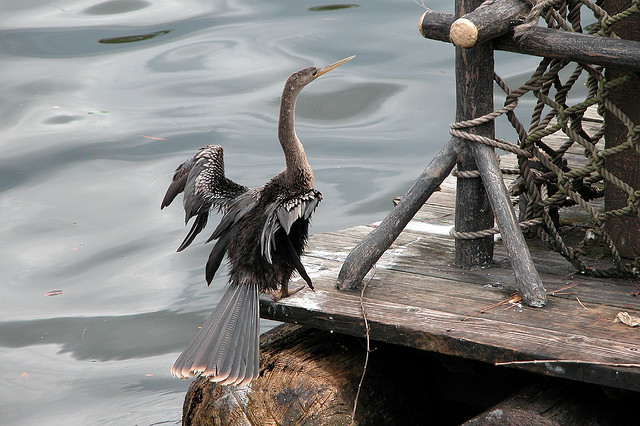
The Osprey: The inspiration behind the original name of Disney’s Osprey Ridge Golf Club (now the Four Seasons Tranquilo Golf Club), ospreys are common in the more wild areas of Walt Disney World. Fish eagles, as some locals call them, love the Seven Seas Lagoon and Bay Lake. Watch for these black-and-white raptors to swoop by as you’re sailing on the ferry to the Magic Kingdom. Ospreys often nest in tall cypress trees along the water, so keep an eye out for their massive, messy nests high in the trees near Ft. Wilderness and Wilderness Lodge.
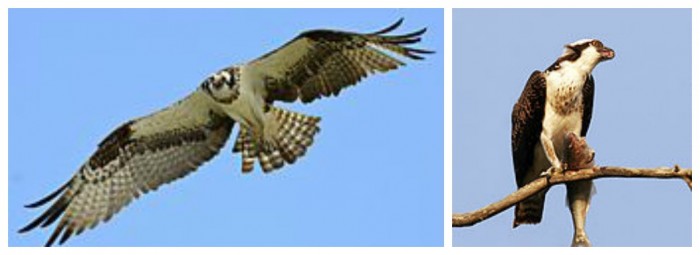
These are just some of the more distinctive birds you can spot at Walt Disney World. Keep a look-out and you never know what you might spot. One day last October, a bald eagle swooped right over my head outside the Morocco pavilion in World Showcase at Epcot. Along the waterways between resorts and parks, I’ve seen red-winged blackbirds in the trees, purple gallinules paddling amongst the water lilies, and little blue herons lurking in the tall grass at water’s edge. There are smaller fishing birds like the green heron and the kingfisher, and raptors like the Red-Tailed Hawk and the frankly adorable little American Kestrel. What birds will you spot next time? Grab a checklist at the Great Florida Birding Trail and add native Floridian birds to your next Disney World vacation.





Boardwalk is a resort in between EPCOT and Hollywood Studios! “Studio” is a shorthand for Disney’s Hollywood Studios.
What boardwalk and studio
Wonderful article!!
This past weekend, we saw a small group of limpkins on the walk between the Boardwalk and the Studios. They weren’t at all shy. We got within 2 feet of them as we were walking along, so I was able to snap a picture to identify them later, as for all my years in Florida, I had never seen one before.
When we first moved down here in April, there was a pair of swallow-tailed kites that we always saw around the “woodpecker preservation zone” at the Epcot parking lot. Haven’t seen them in the past couple months, so I’m guessing they have moved on for the season.
Very cool article!
Wow, I have never seen swallow-tailed kites around WDW – I thought they were too shy! I see them out on the prairies to the west though. I wonder if they are growing more numerous – years ago I rarely saw them. Maybe we’ll have more of them – that would make me so happy! Wonderful birds.
Egrets….I’ve fed a few.
This was a great post! One of my favorite things about living in Florida is getting to see these gorgeous birds so frequently. While I knew the names of most of these guys, I didn’t know the differences between the egrets, so thanks! Hopefully this will help spread the joy and a few bits of knowledge with not only those who visit, but those who live here, too.
Fantastic, super interesting blog! I’m so in love with all the “Disney” birds and wildlife and very happy to know them much better now. It’s always amazing, if people care about the animals in and around Walt Disney World and enjoy them like I do! Thanks for sharing. 🙂
Thank you Vanessa! I didn’t even mention the huge wild turkeys you see running around near the MK toll plaza and Ft. Wilderness, guess there is plenty more to write about with the wildlife at WDW!
So true Natalie! I really can’t wait to read more. Great job and thanks for sharing and replying!
This was definitely on my ‘list of things to learn’ about Orlando!
I often notice that many of the birds had large slender beaks, perfect for fishing, but ashamedly kind of dismissed them as all being Ibis or Heron.
Thanks for stirring my curiosity further.
Wish they weren’t so ‘pecky’ in the parks, as our youngest daughter is literally terrified by them.
Awesome, Kev, I’m so glad you find it helpful!
The birds in Florida are truly amazing. Don’t forget that you can see some unique prairie species like the Caracara if you venture south to the prairies at the Disney Wilderness Preserve. And if you see anything special WDW, take a picture so you can identify it on the internet later. You never know what you will spot!
I used to see a Green Heron all the time in the early mornings between Liberty Square and Frontierland, in that little stream of water by the DVC outpost. Despite growing up on Florida ranchland that’s one of the few times I’ve seen one up close.
I remember one summer a Louisiana Heron used to visit the retention pond behind Splash Mountain every single evening, and again I think that was my first Louisiana Heron! WDW is just so rich in bird life.
I hope your daughter is able to enjoy them more in the future. A good foot stamp and arm wave should send even the boldest bird away – maybe teach her that and she’ll feel more confident. Unfortunately people WILL feed them and that makes them a nuisance. They have plenty of food without resorting to turkey legs and sugary crumbs.